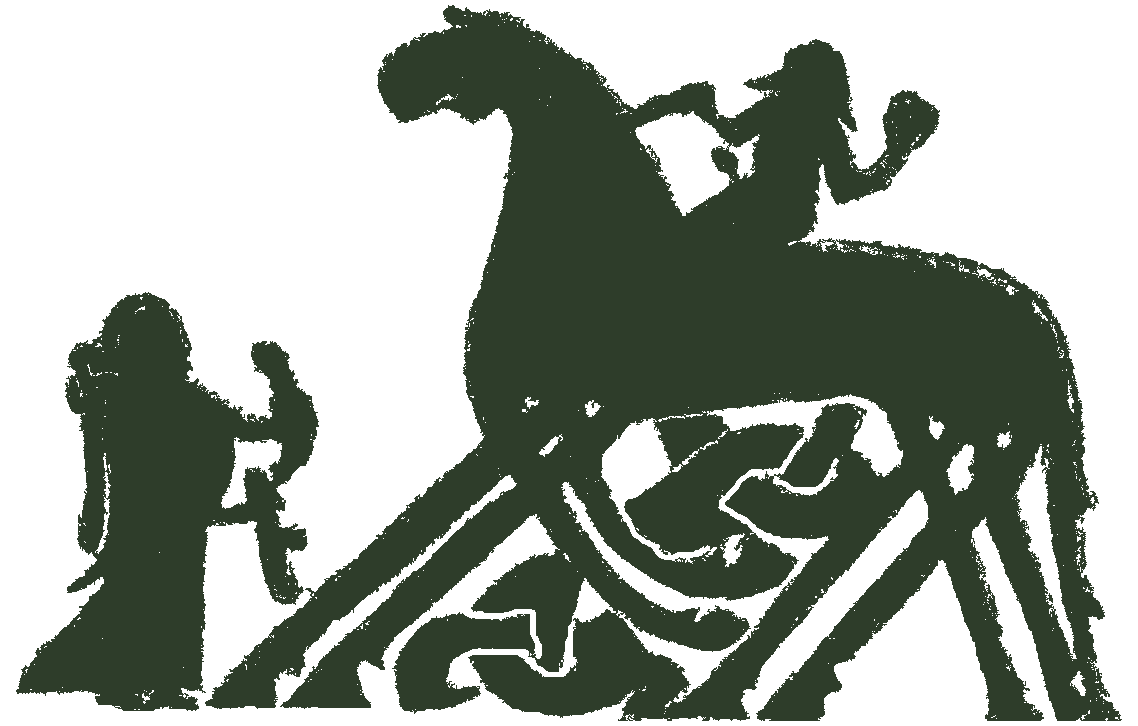in progress
Freyja obtains a gold necklace forged by four rock-dwelling dwarves.
text
[excerpt from] Sǫrla ch. 1c
1c. [Frá Freyju ok dvergum]
Menn þeir váru í Asía, er einn hét Álfrigg, annarr Dvalinn, þriði Berlingr, fjórði Grérr. Þeir áttu heima skammt frá höll konungs. Þeir váru menn svá hagir, at þeir lögðu á allt gerva hönd. Þess háttar menn, sem þeir váru, kölluðu menn dverga. Þeir byggðu einn stein. Þeir blönduðust þá meir við mannfólk en nú. Óðinn unni mikit Freyju, enda var hún allra kvenna fegrst í þann tíma. Hún átti sér eina skemmu. Hún var, bæði fögr ok sterk, svá at þat segja menn, at ef hurðin var aftr ok læst, at engi maðr mætti koma í skemmmuna án vilja Freyju. Þat var einn dag, er Freyju varð gengit til steinsins, hann var þá opinn. Dvergarnir váru at smíða eitt gullmen. Þat var þá mjök fullgert. Freyju leist vel á menit. Dvergunum leist ok vel á Freyju. Hún falaði menit at dvergunum, bauð í móti gull ok silfr ok aðra góða gripi. Þeir kváðust ekki féþurfi, sagðist hverr vilja sjálfr sinn part selja í meninu ok ekki annat fyrir vilja hafa en hún lægi sína nótt hjá hverjum þeira. Ok hvárt sem hún lét at þessu komast betr eða verr, þa keyptu þau þessu. Ok at liðnum fjórum náttum ok enduðum öllum skildaga, afhenda þeir Freyju menit. Fór hún heim í skemmu sína ok lét kyrrt yfir sér, sem ekki hefði í orðit. | There were four men in Asia called Álfrigg, Dvalin, Berlingr and Grérr, who dwelt not far from the King's hall, and who were so clever that they could turn their hands to anything. Men of this kind were called dwarfs. They dwelt in a rock, but at that time they mixed more with men than they do now. Óðinn loved Freyja very much, and she was the fairest of all women in her day. She had a bower of her own which was beautiful and strong, and it was said that if the door was closed and bolted, no-one could enter the bower against her will. It chanced one day that Freyja went to the rock and found it open, and the dwarfs were forging a gold necklace, which was almost finished. Freyja was charmed with the necklace, and the dwarfs with Freyja. She asked them to sell it, offering gold and silver and other costly treasures in exchange for it. The dwarfs replied that they were not in need of money, but each one said that he would give up his share in the necklace [and they didn’t want anything else, but that she would lie by each of them for a night. And whether she agreed to this for better or worse they, Freyja and the dwarves, then agreed on it]. And at the end of four nights they handed it to Freyja. She went home to her bower and kept silence about it as if nothing had happened. |
[status: unverified copy]
commentary
context
This short story or 'þáttr' occurs in the Flateyjarbók version of Ólafs saga Tryggvasonar (long version), but has very little to do with King Ólafr himself. The first part of the þáttr is concerend with the gods, and the theft of Freyja’s necklace by Loki. Óðinn promises to return the necklace on the condition that Freyja causes two kings to engage in perpetual battle. The second part of the þáttr deals with the adventures of Sörli, a Viking prince, and another prince, Högni. The þáttr ends with the perpetual battle between Héðinn and Högni, thereby fulfilling Freyja’s promise. In this episode, Freyja uses her charm to obtain the gold necklace forged by the dwarves. Finnur Jónsson dates the story to the first half of the 14th century.
commentary
(Contributed by Anna Millward.)
tags
Main text: Sǫrla þáttr
Attributes: Gold Silver Dvergr Freyja associated with precious objects Freyja associated with promiscuity
Text sections: Anon Sǫrla 1cVIII
